Thunder in God’s Country: Interview with Jeffrey Mariotte
With a writing and editing career that spans decades, Jeffrey J. Mariotte has done everything. From working in the comics industry (at major publishers IDW, DC, and Wildstorm), penning novels and comic books of popular IPs (such as CSI, 30 Days of Night, Buffy/Angel, Conan the Barbarian, Star Trek, and many others), to his own fiction work that encompasses a variety of genres (especially the western), Mariotte’s canon is impressive and prolific.
By his own admission, one thing Mariotte has not yet done is be a guest of honour at a pop culture convention. That career milestone is about to be crossed off his list as Mariotte will be the guest of honour at the upcoming Edgar Rice Burroughs Chain of Friendship (ECOF) Gathering that will be held in Willcox, AZ the 25th to the 28th of September. Mariotte, who wrote the Tarzan novel Tarzan and the Forest of Stone, is the perfect guest for this event being held in the town that is central to the mythology of the American west as it is the birthplace of Rex Allen and the burial spot of the youngest of the Earp brothers, Warren Earp.
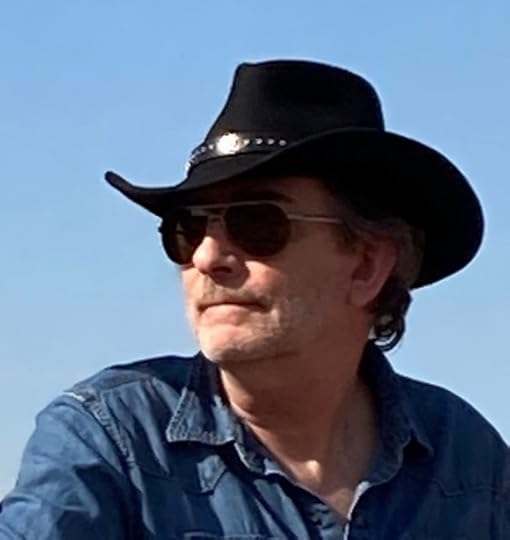 Jeffrey Mariotte author photo (provided courtesy by Mariotte).
Jeffrey Mariotte author photo (provided courtesy by Mariotte).In anticipation for this upcoming event, Mariotte has graciously allowed me to interview him about his writing, westerns, working with IPs, Edgar Rice Burroughs, and Tarzan.
As scholar of sword and sandal films, my obligatory first question has to be peplum related. Growing up, did you watch any old school sword and sandal films? Was it a genre you liked or had interest in?
I definitely did. The animated skeletons in Jason and the Argonauts both fascinated me and scared the crap out of me. Around the same time, I found Ben-Hur and Spartacus riveting (except I found the leper colony scenes in Ben-Hur disturbing, but the chariot race more than made up for it). My parents also took me to see Whatever Happened to Baby Jane in the theater in 1962, I don’t think they were intentionally trying to mold a horror writer, but it didn’t hurt.
From those roots, I graduated to swashbucklers on film and TV. I loved Disney’s Zorro, Errol Flynn’s The Adventures of Robin Hood and Captain Blood, and their ilk. Also, Johnny Weissmuller’s Tarzan, it should go without saying, and later the Ron Ely TV version. I spent four years, from the ages of 5 to 9, in France, where my father worked for the US Department of Defense and where old buildings, bridges, etc. were really old. Every antique store had swords and other forms of ancient weaponry galore, and I was enthralled by all that. I also fell in love with comic books there, which will become important later in this interview. In the summer between junior high and high school, I went back to France on a student trip, and I came home with a WWI-era Austrian light cavalry saber (in 1969, you could strap that to your suitcase and still get onto an ocean liner). In high school I took up fencing and archery, and I continued fencing in college.
Sword and sandal, of course, leads to sword and sorcery. You worked on a few Conan novels in the Age of Conan line: Ghost of the Wall (2006), Winds of the Wild Sea (2006), and Dawn of the Ice Bear (2006). How did you get involved with writing Conan, and was Robert E. Howard an author who had an influence on you?
My discovery of Conan came with the Lancer paperback series, particularly Conan the Barbarian, with Frank Frazetta’s Conan wrestling a huge ape with a red cape. Once I read one – and they tied directly in with my fencing interests and growing sword collection – I had to read them all. And the comics. And then Leiber and Moorcock and everybody else. The early 1970s were the golden age for sword and sorcery fans.
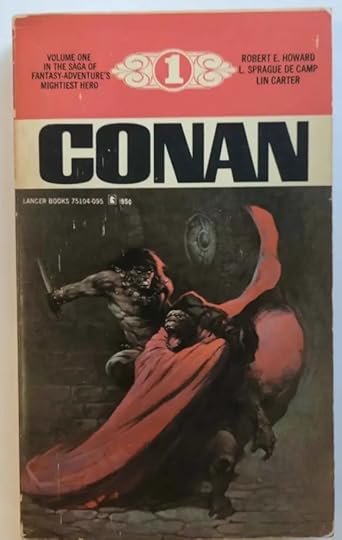 Lancer paperback of Conan photo provided courtesy of Oliver Brackenbury of New Edge Sword and Sorcery.
Lancer paperback of Conan photo provided courtesy of Oliver Brackenbury of New Edge Sword and Sorcery. When the Age of Conan MMORPG came out, I had a friend who worked for Ed Pressman, who was somehow involved with the Conan rights and an executive producer on the first two movies (uncredited on Destroyer). That friend was dealing with Ace books on the tie-in novels, and he came to me and asked if I wanted to write them. The remit was to write books set in Conan’s Hyborian Age, but without Conan as a main character, fleshing out the rest of the world. I mostly did that, but I did slip in a Conan cameo appearance, and they let me keep it, so I became the first writer in the 21stcentury to write Conan into a novel.
I don’t know that Howard was an influence on me stylistically, but in terms of inspiration, he absolutely was. I admire his work tremendously and his imagination even more. As an adult, I was lucky enough to meet Mike Moorcock and Fritz Leiber and L. Sprague de Camp and many of the other writers who toiled in those fields during my early days of discovery. Later I also met Roy Thomas and Gerry Conway and Barry Windsor-Smith and Neal Adams, and a bunch of the folks who made the early Marvel run so great.
The Age of Conan is still going, albeit far from as popular as its heyday, but it is one of those few post-World of Warcraft MMORPGs that still survives. Did you ever play the game perchance? Or perhaps dive into any other MMOs out there?
I have the game box with its cool physical elements, but I gave my free code to play to a friend, because I don’t play MMOs at all. I was actually involved with two – I also wrote and edited a comic book that tied into the 2009 MMORPG Freaky Creatures, which apparently never really caught on with its target audience.
What was your introduction to the work of Edgar Rice Burroughs (ERB)?
I wish that I could remember the exact progression of that process. It started with Johnny Weissmuller’s movies, as mentioned earlier. They were seemingly on TV every week in my childhood and watching them created a fascination with jungle adventure movies that has never waned. At some point, I became aware that there were books behind them. I was also aware of the book All in Color for a Dime, by Richard A. Lupoff and Dick Thompson, because of my growing comics hobby. I read some of Lupoff’s novels, and I ran across his Burroughs book Master of Adventure. That was my entrée into the world of Burroughs scholarship. While I was attending San Jose State University, I met Dick, who just lived up the bay in Berkeley with his wife Pat, and that started a friendship that lasted the rest of his life.
Somewhere in between those things, I think after my discovery of Conan, but it might have been before, and getting to know the Lupoffs, I had read at least a few of the Tarzan books, some John Carters, some David Inneses, some Carson Napiers, and maybe a few others. Sadly, I didn’t keep reading journals or have the encyclopedic memory that a lot of Burroughs fans and scholars seem to.
Burroughs had written a handful of Westerns: The Bandit of Hell’s Bend (1924), The War Chief (1927), Apache Devil (1933), and The Deputy Sheriff of Comanche County (1940). Have you read some of his Westerns and if so, any impressions you have about them?
I love ERB’s westerns, especially the two Shoz-dijiji books. After thirty-one years living in California, I moved to a 40-acre chunk of land in southeastern Arizona’s Cochise County. I was near the south end of the Sulfur Springs Valley, just north of Douglas. When he was at Fort Grant, ERB was at the north end of the same valley. So those books, which take place in my old stomping grounds and involve Apache people and customs that I’ve also studied and written about, were wonderful discoveries. Of course, John Carter spent time there as well. I’d still love to do something fictional based around Ed’s period at Fort Grant.
What are some of your books that showcase your scholarship and writing about Apache peoples and their traditions that you’d like to spotlight?
I wouldn’t go so far as to say “scholarship,” but Apache characters and culture have played roles in many of my books, including the Desperadoes comics series, Deadlands: Thunder Moon Rising, and my Cody Cavanaugh traditional Western novel series (currently out of print but due to be reissued sometime soonish).
Regarding Western literature, what would you say have been the biggest changes and shifts in the genre between Burroughs’ time to now?
The most substantive change, I think, is that today’s Westerns can be more realistic. Note that I didn’t say they “are,” because some definitely are not. But the option exists, in today’s Western fiction, to explore the rampant racism and sexism of the era, and on the flip side, to acknowledge that minorities and women were integral to the “settling” of the American West. In Burroughs’s day, if a character in a Western lived in poverty, it was probably a humorous minor character who was made fun of because he was poor. The truth is that a lot of people spent everything they had to go west, in search of their fortunes, but those fortunes never materialized. Diseases were romanticized, and generally easily cured through the accumulation of wealth, the wisdom of a kindly old doctor, or the love of a good woman. And of course, the single most significant fact of westward expansion was the genocidal effect on the Indigenous population—which, in some ways, continues today. Now, Western writers are able to address all of these situations in a more genuine fashion, pointing out the difficulties and terrors of the westward movement without relying on the stereotypes.
Going back to your adoration of Jason and the Argonauts, one cannot help but think of Harryhausen’s Weird Western The Valley of Gwangi (1969). Do you have any affinity to other Western subgenres, such as the Weird Western, Acid Westerns, neo-Westerns, etc.? Are these subgenres ones you like to write in?
I don’t think I’ve ever actually seen The Valley of Gwangi, though of course I’m aware of it. I should really track it down one of these days. I love Weird Westerns and actually began my career in Western literature with those, specifically with my 1997 comic book series, Desperadoes, which was very definitely Western horror. I tried to use real places and some real people and situations in the book, but all overlaid with supernatural horror. The series ran from 1977 to 2007, and I’ve recently written a short story involving those characters (in my collection Byrd’s Luck & Other Western Stories). I have an artist ready to go on what will be the last Desperadoes story, bringing the adventures of those characters to some kind of satisfactory conclusion. What we don’t have yet is a publisher willing to take it on.
I’ve also written several Weird Western shorts – the short-fiction collection mentioned above is split, with half of the stories being traditional Westerns and half Weird Westerns. And I wrote one of three novels based on the Deadlands RPG for Tor Books. Finally, I’m the unofficial “official” reviewer of Weird Western books for both True West and Roundup magazines (Roundup being the official magazine of the Western Writers of America, of which I’m a proud member).
As one last example, most of my original novels are set in the west and sometimes include aspects commonly seen in traditional Westerns. In my horror novel Missing White Girl, for example, the sheriff’s deputy who is the primary protagonist also owns a ranch and holds some ideals more closely related to the Old West than to the new one.
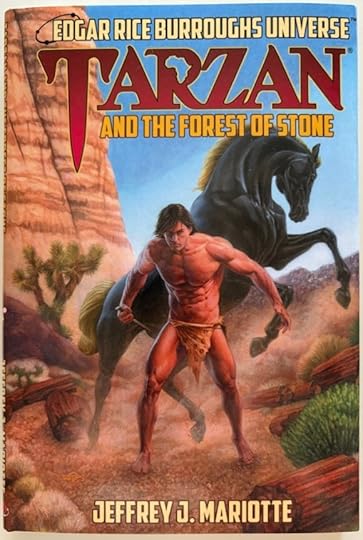 Hardcover of Tarzan and the Forest of Stone
Hardcover of Tarzan and the Forest of StoneYour contribution to the Burroughs canon is with your novel Tarzan and the Forest of Stone (2022). What was the genesis of this project? How did it come about?
Speaking of the Sulfur Springs Valley, in 2019 my friend Bob Boze Bell of True West Magazine fame was the guest of honor at the Dum-Dum that Frank Puncer put on in Willcox. I accompanied Bob, and we had a grand old time getting to meet Burroughs fans and listening to scholarly talks and so on. Some of the folks from ERB, Inc., including Jim Sullos and Christopher Paul Carey, were also there. I got talking to them, and by the end of the event, Chris and I had pretty much agreed to do something together. Then he pitched me on writing a Tarzan novella, and I jumped at the opportunity. It was a true gift.
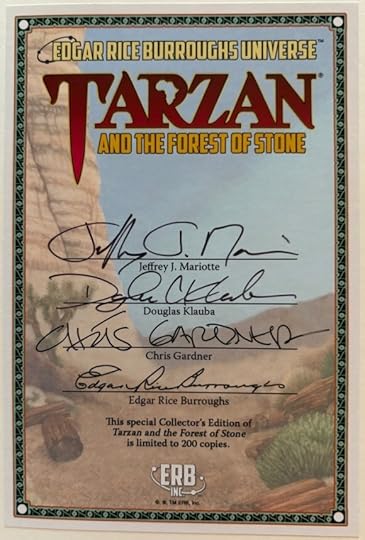 Bookplate for Tarzan and the Forest of Stone.
Bookplate for Tarzan and the Forest of Stone.What obstacles did you encounter combining Tarzan with the Western? What was something neat you learned in the process of doing so?
I don’t remember any particular obstacles. I was putting Tarzan in a setting that was largely unfamiliar to him, the desert landscape of northern Arizona is as different from the deserts of northern Africa as the moon is to the Earth, but with the understanding that Tarzan is at home in nature, and not a guy who needs a lot of time to get acclimated to new things. I had a lot of fun with the opening section, involving Tarzan’s visit with a writer we all know and love, and I tried to get that part right, which meant learning about the house and grounds, the views from there. I also learned a lot about the Atcheson, Topeka, and Santa Fe’s The Chief, which at the time was the fastest way to travel from coast to coast. I love trains, so really enjoyed discovering the details of that journey (and finding out that its real schedule fit my story just right).
You have a tremendous history of dealing with other IPs and media tie ins, be it from the publishing side such as working for IDW, DC, and WildStorm, to also an author of numerous novels set in the Buffyverse, Star Trek, CSI, and so on. Working with the Tarzan IP, when compared to other IPs, what was that like? What was similar and what was different?
I’ve written a ton of licensed fiction, as you say. Tarzan was different in several ways. First, as a character, he’s one of the very few who’s known to almost everybody around the world. Tarzan, Sherlock Holmes, Mickey Mouse, maybe Superman and Spider-Man, and that’s about it. So, I knew there would be a lot of fans, some of them hardcore Burroughs enthusiasts who don’t want other people messing with their guy, some of them fans of the existing stories and willing, even anxious, to read new ones. He’s also appeared in virtually every form of mass media, from the books to movies and TV, radio, newspaper strips, comics, and more. Basically, nobody was going to pick up the book not knowing who Tarzan is and a bit about his background. That’s part of why he’s fun to write, but also part of why it’s scary, everyone’s already got an opinion, got their version of him in their head. I wanted to try to stay true to how I see him while not negating how somebody else sees him.
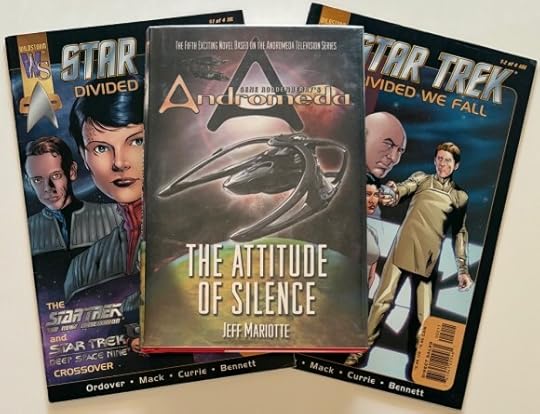 Scifi IPs that Mariotte has worked on.
Scifi IPs that Mariotte has worked on. Most of the other IPs I’ve written are well-known, but not that well-known. I’ve written Superman, Spider-Man, and Zorro, and those probably come closest. But Buffy and Angel, CSI, NCIS, etc., are considerably more modern. There are at most a few decades of stories in existence about them, and most people’s impressions of them were formed from the same source: television. Other novels exist, but I was writing mine at the same time that those novels were coming out, so there’s a basic continuity that everyone sort of agrees on. And in some of those cases, if I have a question, as a writer I can basically go to the source for an answer. I knew people in the CSI production office when I was writing CSI. I’d spent time with Joss Whedon and Anthony Zuiker, so when I wrote Buffy the Vampire Slayer and Angel, CSI, The Shield, and Las Vegas, I’d actually spoken with Whedon and Zuiker and Shawn Ryan and Gary Scott Thompson, the creators of those properties. That doesn’t mean I can’t make mistakes in continuity, but it means they’re less likely to happen. I’d have to have H.G. Wells build me a time machine to talk to Edgar Rice Burroughs, and sadly, I don’t think that’s likely to happen.
Having written across a variety of mediums (books, comics, etc.), your own work and other IPs, what project have you been a part of that was unique to you and put you out of your comfort zone or was incredibly off beat? Perhaps the most unexpected outlier in your bibliography?
I’d have to say that’s my one solo nonfiction book. I cowrote behind-the-scenes episode guides for Buffy the Vampire Slayer and Angel, but those were not entirely my work, and they involved properties that I’d also written novels about. The one I wrote by myself is Criminal Minds: Sociopaths, Serial Killers & Other Deviants (which was not my title, because I would at least have used the Oxford comma). It’s not too far out of my zone because it’s true crime, but “true” isn’t typically used in connection with my book output. This one was licensed nonfiction that described all the criminals mentioned by name in the first five seasons of the Criminal Minds TV series, along with crimes that inspired episodes but weren’t specifically mentioned.
That obviously required tons of research. The ones named on the show were no problem, but many episodes use elements of real crimes and criminals, and I had to be familiar enough with both the show and the real-life counterpart to identify them. I did most of the writing during the months of November and December, so while other people were watching Thanksgiving Parades and Christmas specials, I was digging deep into the likes of Jeffrey Dahmer, Edmund Kemper, and the Mad Butcher of Kingsbury Run. The research phase was a real immersion into the darkest depths of human behavior, and very unpleasant. But it also led to the writing of my crime novel Empty Rooms, which I believe is one of my best books.
You are the Guest of Honour for the upcoming Edgar Rice Burroughs Chain of Friendship (ECOF) gathering that is being held in Willcox, AZ, at the end of September. Congratulations! While the programming is certainly still being finalized, is there anything you can share that you’re doing at the event?
Thank you! I’m very much looking forward to it. My professional connection to the Edgar Rice Burroughs community came about entirely as a result of having attended the Apache Devils Dum-Dum in 2019. Frank Puncer, who put on that Dum-Dum, is also the driving force behind this one, and I’m looking forward to seeing him and everyone else. And I’m now an official member of the Apache Devils chapter of the Burroughs Bibliophiles.
As for my duties at the ECOF, I know I’m supposed to give a keynote speech, which I should probably start working on one of these days. I’ll have a table where some of my books will be available for sale. And I will, of course, be available to talk ERB with anyone who is so inclined.
A final question, aside from the ECOF appearance, what else do folks have to look forward to coming from you? Any new publications or projects you’d like to mention that readers can keep an eye out for?
Funny you should mention that, because this past Saturday, as I’m writing this [7/26], Edgar Rice Burroughs Inc. announced my next project at the San Diego Comic-Con (an event I attended every year from 1983–2013 but haven’t been back to since). I’m in the midst of writing Beyond Thirty: A World Reborn, an authorized sequel to ERB’s short novel Beyond Thirty, which was originally published in a 1916 issue of All-Around Magazine. In it, naval officer Jefferson Turck and Victory return to Grabritin, and…stuff happens. I don’t know what else I’m allowed to say about it now, so I’ll leave it there.
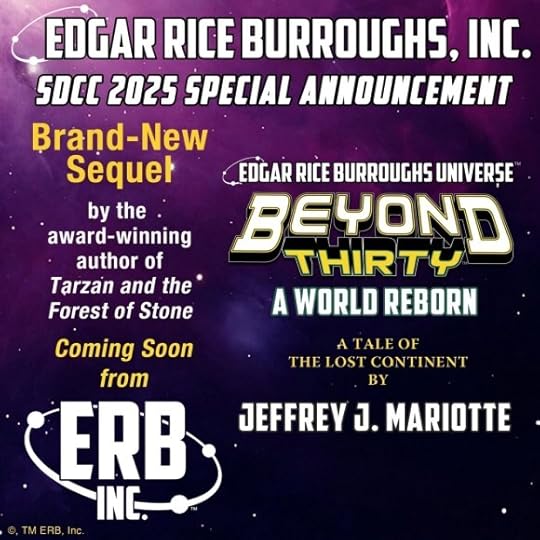 ERB SDCC announcement graphic for Beyond Thirty: A World Reborn.
ERB SDCC announcement graphic for Beyond Thirty: A World Reborn.I’ve also become a publisher of Western fiction, as a partner in Silverado Press. So far, we have four books out, two books in the Galloway’s Gamble series by my partner Howard Weinstein, Byrd’s Luck & Other Western Stories by me, and Silverado Press Presents: Western Stories by Today’s Top Writers, which I edited. We have a new Silverado Classics line launching when I can get around to it, republishing influential classics of Western literature with scholarly essays describing their place in the world of Western fiction.
Sincere appreciation for Jeffrey Mariotte’s time for doing this interview. For more information about Mariotte, news, and his works, check out his website and social medias:
Official WebsiteSubstackBlueSkyFacebookAmazon Author PageFor more information about the 2025 ECOF event, see the below press release and registration form:
Press Release for the 2025 Edgar Rice Burroughs Chain of Friendship (ECOF) Gathering and Monument Dedication in Willcox, AZ (v11)DownloadRegistration Form for the 2025 Edgar Rice Burroughs Chain of Friendship (ECOF) Gathering in Willcox, AZ (v9)Download


